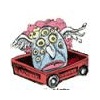Mexican Mafia settled scores with killing at Long Beach homeless camp, records reveal
Published in News & Features
LOS ANGELES -- Prison was Samuel Villalba’s domain.
On the inside, he was Negro from Artesia, a Mexican Mafia member whose word was the law to the thousands of Latino gang members who fall under the syndicate’s influence.
Outside prison, he was an ex-con with a failing liver and a dark past. His once muscular body, tattooed with the black hand of the Mexican Mafia, had grown thin. Home was a tent on the side of a freeway.
Sometime during his 16 years in federal prison, Villalba was cast out of the Mexican Mafia for assaulting a fellow member. The sentence was death. It was carried out by two men who crept through the homeless camp where Villalba lived the evening of Jan. 10, 2021, carrying guns in gloved hands.
The case went unsolved until last month, when the Long Beach Police Department arrested one of the alleged shooters. Andrew Reyna, 48, has pleaded not guilty to murder charges. His attorney declined to comment.
Villalba, 64, was inducted into the Mexican Mafia more than three decades ago while held at Folsom for drug possession, according to prison records reviewed by The Times. His life and death were defined by his membership in an organization whose reach is as long as its memory.
Released in the late 1980s, Villalba came home to southeast L.A. County, where he took part in a push by the Mexican Mafia to bring the region’s street gangs under their control. Summoned to meetings in parks and community centers, crowds of gang members learned they were now obligated to pay “taxes,” an investigation by the Los Angeles County Sheriff’s Department and FBI found. Any who resisted would get the “green light,” meaning they’d be shot on the streets and stabbed behind bars.
Villalba also built a life away from the gang. After getting out of prison, he went to see an old friend from inside. The friend introduced Villalba to his mother.
Pearl Villalba recalled seeing her future husband pull up to their home in a pickup truck, wearing “raggedy” clothes.
“He didn’t interest me at all,” she told The Times.
Villalba, 17 years her junior, asked her out on a date. She declined. He asked every time he saw her. Eventually she gave in.
They went to Ports O’Call, Redondo Beach and Long Beach. He took her to Las Vegas and asked if she’d marry him. She said no. The second time they went to Vegas, she said yes.
Pearl liked that he was kind to her children from a previous marriage. She knew he was involved in prison gangs — “He had a big ol’ ‘M’ on him,” she said, gesturing to her chest — but she didn’t ask.
“He’d say, ‘Don’t worry about it, honey,’” she recalled. “That was their business. Nothing was ever mentioned.”
In Artesia, Villalba got into a bad dispute with young members of his gang who refused to listen to the older ex-convict, according to a secretly taped 1995 meeting reviewed by The Times.
The upstarts were the sons of Luis “Huero Buff” Flores, one of the Mexican Mafia’s founders. “All the rules that we live by today, he’s the one that started them,” another Mexican Mafia member, Raymond Shryock, said at the meeting. “But his family believes that they’re beyond reproach.”
Shryock, Villalba and about a dozen other Mexican Mafia members had gathered in a motel room to talk business. They didn’t know the FBI and Sheriff’s Department had bugged the room with hidden cameras and tape recorders.
Shryock said Flores’ sons “wanted to kill Negro because they thought Negro disrespected them.”
“I know that family,” Shryock continued. “I grew up with them, and I know how they think. So I sat the jefa down. I sat the youngsters down. I said, ‘Look, man. You’re going to respect Sammy.’ I said, ‘You’re going to do what you’re told. You’re not going to step on his toes.’ And I said, ‘If you do, I’ll be the first one to come down here and do something to you.’”
Then Shryock turned to Villalba. He’d been accused of sending a gunman to kill a fellow Mexican Mafia member without the backing of the organization. If true, Shryock warned Villalba, “that’s an automatic death sentence.”
Villalba denied it; Shryock said he believed him. Later that year, both men were indicted in the first racketeering case brought against the Mexican Mafia.
Villalba fled to Arizona, splitting time between Tucson and brief trips to see his family in Southern California, his wife said.
“The feds were watching us at all times,” she said. Once, she said, the FBI sent a “rat” to their house to inquire about her husband.
After five months on the run, agents caught up to Villalba at a motel in Buena Park.
Federal prosecutors charged that he had voted in favor of murdering three Mexican Mafia members who’d fallen out of favor: Conrad “Big D” Garcia, a born-again Christian. Charles “Charlie Brown” Manriquez, an informal advisor to the 1992 film “American Me,” which enraged the Mexican Mafia with its depiction of a founding member being sodomized. And Donald “Little Man” Ortiz, targeted for the vague offense of “disrespecting” the Mexican Mafia.
Garcia died of natural causes in 2012. Manriquez was gunned down in the Ramona Gardens housing project in 1992. Ortiz survived several attacks in prison before a gunman disguised as a detective killed him in Chino in 2021.
Villalba pleaded guilty to racketeering in 1996. While he served a 16-year term, gangs in southeast L.A. County continued to support him, records show.
U.S. Drug Enforcement Administration agents had tapped the phones of the Varrio Hawaiian Gardens gang in 2006 when they overheard two of their targets complaining that Villalba’s wife was asking for money. The gang members agreed to send her $400, reasoning if they gave her too much she’d expect that amount every time, an agent wrote in an affidavit.
But a year later, Villalba was marked for death after assaulting a fellow Mexican Mafia member without the organization’s sanction, according to law enforcement records reviewed by The Times.
His mistakes “couldn’t be fixed,” an inmate at the federal penitentiary in Victorville said in a recorded phone call. “He’d been skating on thin ice for a long time anyway.”
Villalba was exercising on the yard at Victorville when a prisoner sucker-punched him, according to a video reviewed by The Times. Two other inmates beat, kicked and throttled Villalba with a ligature, stopping only after guards doused them with a chemical spray.
Villalba left prison in 2012. He had sent his wife hand-drawn cards for every Valentine’s Day, anniversary and birthday. She kept the correspondence in an album along with his letters and pencil drawings of Mexican revolutionaries and Aztec warriors.
But after getting out, she said, Villalba took up with a new woman. “I waited for him all those years,” she said. “For him to betray me like that — no.”
Still, the two remained cordial, Pearl said. He visited her from time to time, bringing coffee or flowers. Sometimes he slept on her couch. He spent his days riding around the neighborhood on a bicycle and hanging out at a liquor store, Pearl said. She heard he was living in an encampment in the San Gabriel riverbed.
By 2021, Villalba had moved his tent near the 91 Freeway in northern Long Beach. He was suffering from cirrhosis and open sores on his hips, according to a coroner’s report. He’d tried to treat them with a makeshift bandage of paper and tape.
The night of Jan. 10, two men approached the encampment on foot, prosecutors alleged in a complaint. One was Reyna, who had spoken to an unnamed prisoner by phone and promised to “take care of Town Southeast” — a reference to Villalba’s hometown in southeast L.A. County, prosecutors wrote in the complaint.
A member of the Eastside Paramount gang called “Boxer,” Reyna worked under the Mexican Mafia but was not a full-fledged member, according to a law enforcement official who wasn’t authorized to speak publicly.
The second suspect wasn’t identified in the complaint. Both men wore nitrile gloves to avoid leaving fingerprints or DNA, the document says.
The two entered the camp by crawling through a hole in a chain-link fence. According to the complaint, they asked for Villalba, found him and shot him to death in his tent.
©2024 Los Angeles Times. Visit at latimes.com. Distributed by Tribune Content Agency, LLC.







Comments